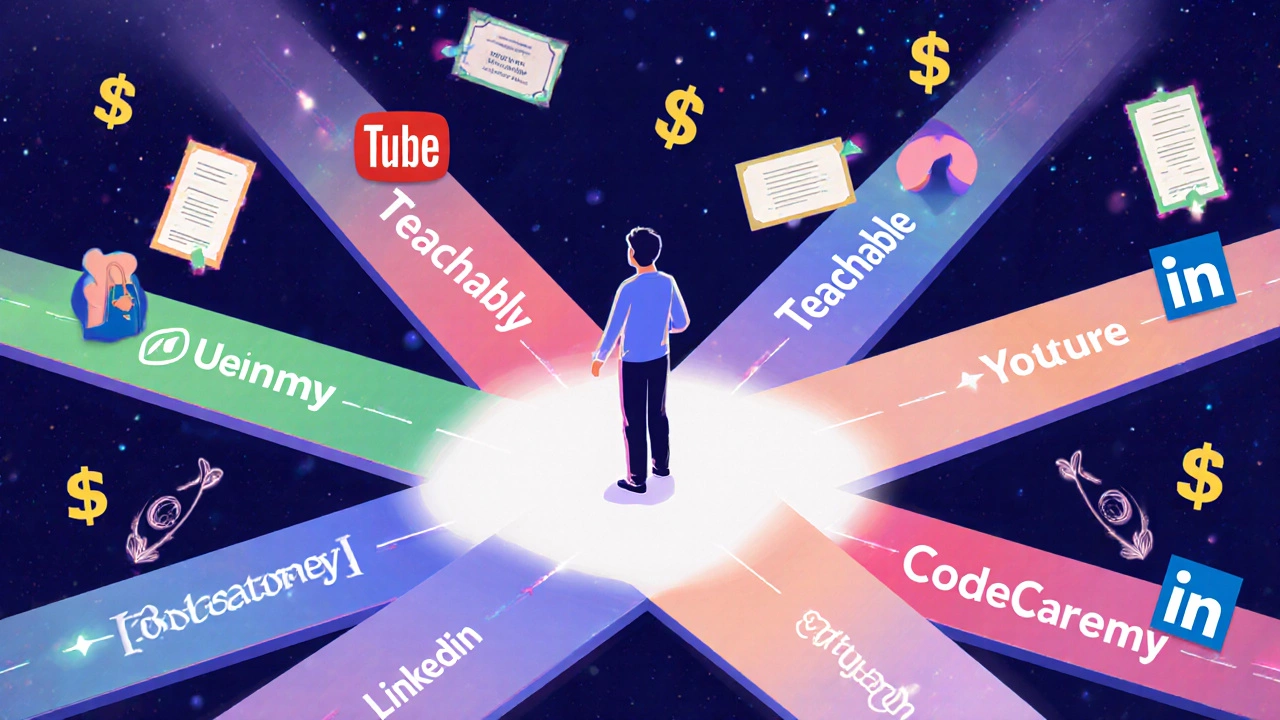Learning Platform Earnings Calculator
Choose Your Platform
Earnings Estimator
Enter your specific details to see realistic earning potential
Estimated Earnings
Select a platform and enter your details to see your estimated monthly earnings
What if you could get paid while you learn? It’s not a dream - it’s happening right now. More people are turning to online learning platforms not just to gain skills, but to actually earn money as they go. Some platforms pay you for completing courses, creating content, teaching others, or even just participating in research. But which ones actually put cash in your pocket - and how much can you really make?
Udemy: Earn by Creating Courses
Udemy isn’t just a place to take courses - it’s one of the top platforms where instructors make real money. If you know something valuable - whether it’s Excel formulas, Photoshop, or Python - you can create a course and sell it. Top instructors on Udemy earn over $100,000 a year. Even average instructors make $1,000 to $5,000 monthly. You keep 97% of sales when you drive your own traffic, and 50% when Udemy promotes your course through their site. The catch? You need to build an audience. A course with 5,000 students at $20 each = $100,000 in revenue. After Udemy’s cut, that’s still $50,000+.
One instructor from Melbourne started teaching basic accounting to small business owners. Within 18 months, he had over 12,000 students. He now earns $8,000 a month passively. No ads, no extra work - just a well-built course that keeps selling.
Teachable: Full Control, Full Earnings
Teachable gives you your own branded learning platform. You host your courses, set your prices, and keep 100% of the revenue (minus payment processing fees). There’s no middleman taking a cut unless you use their built-in marketing tools. If you already have an email list, a YouTube channel, or a social following, Teachable lets you turn that into income fast.
A teacher in Brisbane used Teachable to sell a 6-week course on teaching English to kids. She charged $99 and sold 320 copies in her first year. That’s $31,680 in revenue - all from her own network. She didn’t pay for ads. She didn’t rely on platform traffic. She just created something useful and shared it with people who needed it.
LinkedIn Learning: Paid for Watching
Unlike most platforms, LinkedIn Learning doesn’t pay you to teach - it pays you to learn. Through their Learning Credits program, companies buy licenses for employees. If your employer uses LinkedIn Learning and you complete a course, you might get a bonus, gift card, or even a raise - but only if your company offers it. It’s not direct payment from LinkedIn, but it’s real money tied to learning.
Some Australian firms like Atlassian and Commonwealth Bank give employees $500-$1,000 in learning credits per year. Employees who finish 10+ courses get a $200 bonus. It’s not huge, but it’s cash for doing something you’d do anyway. And you get a certificate to add to your LinkedIn profile.
Coursera: Earn Through Partnerships
Coursera partners with universities and companies to offer degrees, certificates, and specializations. Most learners pay to enroll - but there’s a way to earn. Coursera’s Guided Projects let you complete hands-on tasks and get paid for contributing to real-world research. For example, data analysts can help clean datasets for academic studies and earn $15-$30 per project.
Also, if you’re a university graduate or professor, you can apply to become a course creator. A lecturer in Sydney created a Coursera course on sustainable business practices. It’s now taught in 12 countries. She earns $12,000 annually in royalties - with no extra work after the first month of filming.

YouTube: Learn and Get Paid for Teaching
YouTube isn’t a traditional learning platform, but it’s one of the highest-paying places to turn knowledge into income. If you create educational content - like “How to use Canva,” “Python for beginners,” or “Investing for teens” - you can earn from ads, sponsorships, and memberships.
A 22-year-old from Perth started posting 10-minute tutorials on budgeting. Within a year, she hit 200,000 subscribers. She now makes $15,000 a month from YouTube ads and $8,000 from sponsored content. Her biggest video? “How I paid off $18,000 in student debt in 14 months.” It’s been viewed over 4 million times.
The key? You don’t need fancy gear. Just a phone, a quiet room, and clear explanations. YouTube pays based on views and watch time - not on how many people sign up for your course.
MasterClass: High-Paying Instructors Only
MasterClass is exclusive. They only accept world-class experts - chefs, filmmakers, athletes, CEOs. If you’re selected, you can earn six figures for a single course. But getting in is nearly impossible. They don’t take applications. They scout talent.
One Australian chef was invited after his cooking videos went viral on Instagram. He filmed a 10-hour course on modern Australian cuisine. He got a $250,000 upfront payment and 15% of sales. His course has sold over 100,000 copies. That’s $375,000 in royalties - and counting.
For most people, MasterClass is out of reach. But it shows what’s possible when you have a unique skill and a big audience.
Codecademy: Learn to Code, Get Hired
Codecademy doesn’t pay you directly - but it connects you to jobs that do. Their Pro Intensive programs include career coaching, portfolio building, and job placement. Graduates often land roles paying $70,000-$110,000 a year in Australia.
One student from Adelaide completed Codecademy’s Full Stack Developer track in 6 months. He applied to 12 jobs through Codecademy’s job board. He got two offers. He chose one at a fintech startup paying $85,000 plus 1% equity. His learning platform didn’t pay him - but it led to a job that paid $7,000 a month.
How Much Can You Really Make?
Here’s a realistic breakdown of potential earnings:
- Course creator on Udemy/Teachable: $500-$5,000/month (after 6-12 months of building)
- YouTube educator: $2,000-$20,000/month (depends on audience size)
- MasterClass instructor: $250,000+ upfront + royalties (rare, elite only)
- Coursera course creator: $5,000-$20,000/year in royalties
- LinkedIn Learning learner (with employer bonus): $200-$1,000/year
- Codecademy graduate (job placement): $70,000-$120,000/year salary
The highest earners aren’t the ones who just take courses. They’re the ones who create them, teach them, or use them to land better jobs.

Who Should Choose What?
- If you’re an expert: Go to Teachable or Udemy. Build your own course. Keep the most money.
- If you’re good on camera: Start a YouTube channel. Focus on solving one problem clearly. Monetize with ads and sponsors.
- If you want a job: Use Codecademy, Coursera, or LinkedIn Learning to get certified. Then apply for roles.
- If your employer pays for learning: Take every course. Claim your bonus. It’s free money.
Common Mistakes to Avoid
- Thinking you’ll make money fast. Most top earners spent 6-12 months building before seeing real income.
- Creating courses with no audience. You need people who care about your topic before you sell.
- Ignoring SEO. If your course or video doesn’t show up in search, no one will find it.
- Not updating content. Tech changes fast. A course from 2020 might be outdated in 2025.
Start Small, Scale Fast
You don’t need to be an expert to start. You just need to know more than someone else. Record a 5-minute video explaining how to use a free tool. Post it on YouTube. See if people engage. If they do, make another. Keep going.
One person in Perth started by teaching her mum how to use Zoom. She filmed it, uploaded it, and added subtitles. That video got 12,000 views. She made $300 from YouTube ads. She turned it into a series. Now she has 80,000 subscribers and earns $4,000 a month.
The platform that pays the most isn’t the one with the biggest name. It’s the one you use the right way.
Can you really make money learning online?
Yes - but not just by taking courses. You make money by creating content, teaching others, or using skills you learn to land higher-paying jobs. Platforms like Udemy, YouTube, and Teachable let you earn directly. Others like Codecademy connect you to jobs that pay well.
Which platform pays the most for instructors?
Teachable pays the most because you keep 100% of sales (minus payment fees). Udemy can pay more in volume if your course goes viral, but they take a big cut. MasterClass pays the highest upfront fees - but only if they invite you.
Do I need to be an expert to earn on these platforms?
No. You just need to know more than your audience. Many top YouTube educators started by teaching basic skills - like how to use Excel or fix Wi-Fi. You don’t need a degree. You need clarity and consistency.
How long does it take to start earning?
Most people see their first income after 3-6 months of consistent effort. Building an audience, creating quality content, and optimizing for search takes time. The first $100 might take 100 hours. The first $1,000 might take 300 hours. But after that, it scales.
Are free courses worth it if they don’t pay?
Yes - if they lead to something that does. Free courses on Coursera or LinkedIn Learning can help you get certified, build a resume, and land a job that pays $80,000+. The learning itself is free - the payoff is in the job.
What to Do Next
Here’s your 3-step plan:
- Identify one skill you know better than 5 other people. It could be anything: organizing files, making spreadsheets, explaining taxes, fixing a leaky tap.
- Record a 7-minute video explaining it. Use your phone. No fancy editing needed.
- Upload it to YouTube or post it on Reddit. See if people comment, like, or ask questions.
If they do - you’ve found your starting point. The platform that pays the most is the one you begin with today - not the one you dream about tomorrow.

